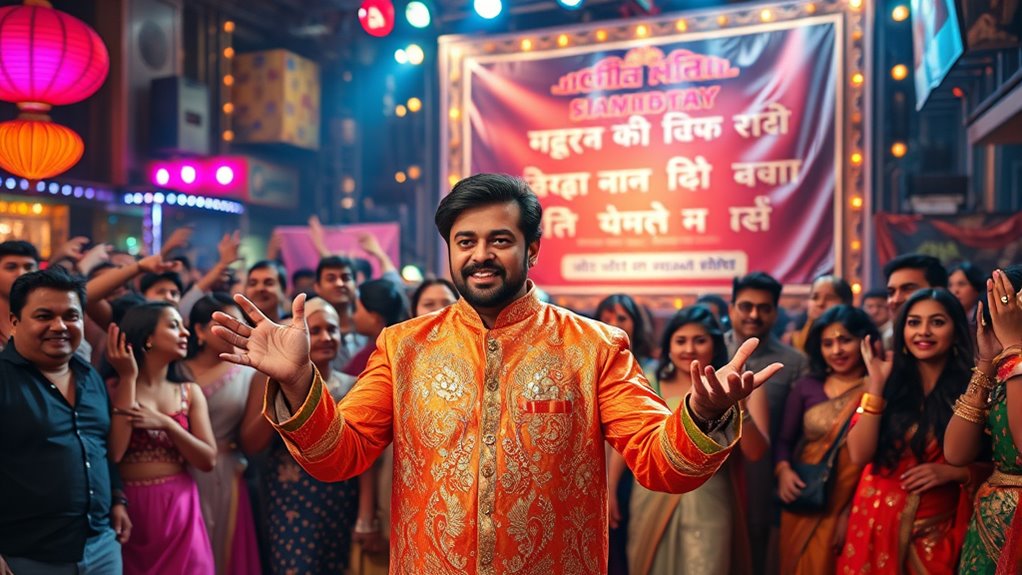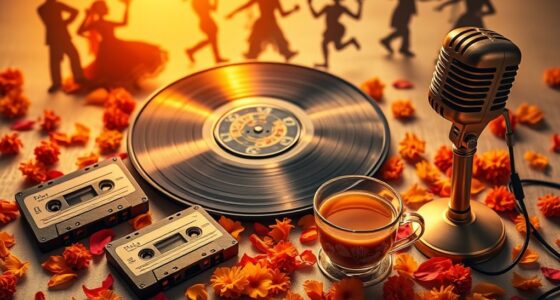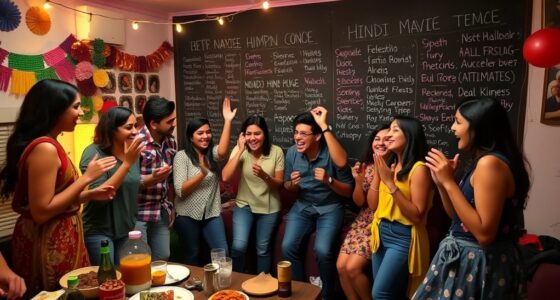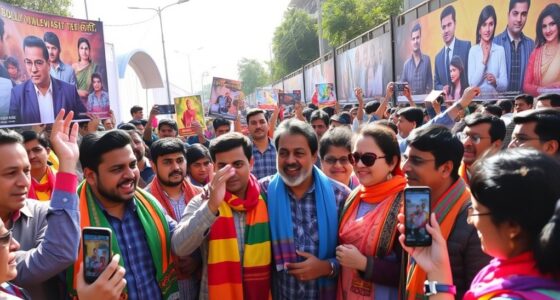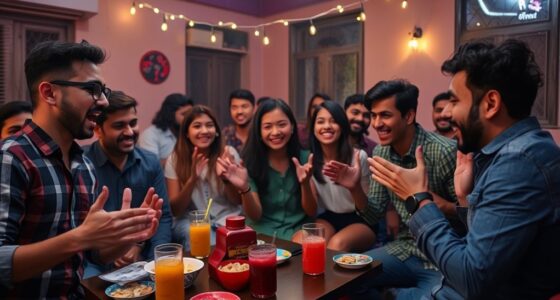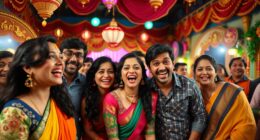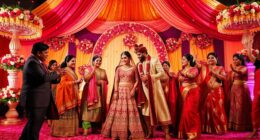To master Bollywood slang, you need to know terms like “Jhakaas” and “Dhaansu” for excitement, “Pataka” for attractive women, and “Yaar” for friends. Learn playful insults like “Chirkut” or “Dhakkan,” and fun expressions like “Mast” or “Gyaan” for good times. Casual phrases like “Jugaad” and “Chull” capture youth spirit. Keep exploring these lively terms to truly understand Bollywood’s colorful language and vibe.
Key Takeaways
- Familiarize with expressive terms like “Jhakaas” and “Dhaansu” that convey excitement and admiration in Bollywood slang.
- Learn descriptive words such as “Pataka” and “Fullmoon” to comment on appearance and personality traits.
- Use casual terms like “Yaar” and “Mast” to add warmth, camaraderie, and fun to conversations about movies.
- Recognize playful insults like “Chirkut” and “Dhakkan” that reflect humor and social teasing in film dialogues.
- Understand regional influences and cultural context behind slang terms to appreciate their usage and significance in Bollywood culture.
Understanding the Expressive Power of Jhakaas and Dhaansu
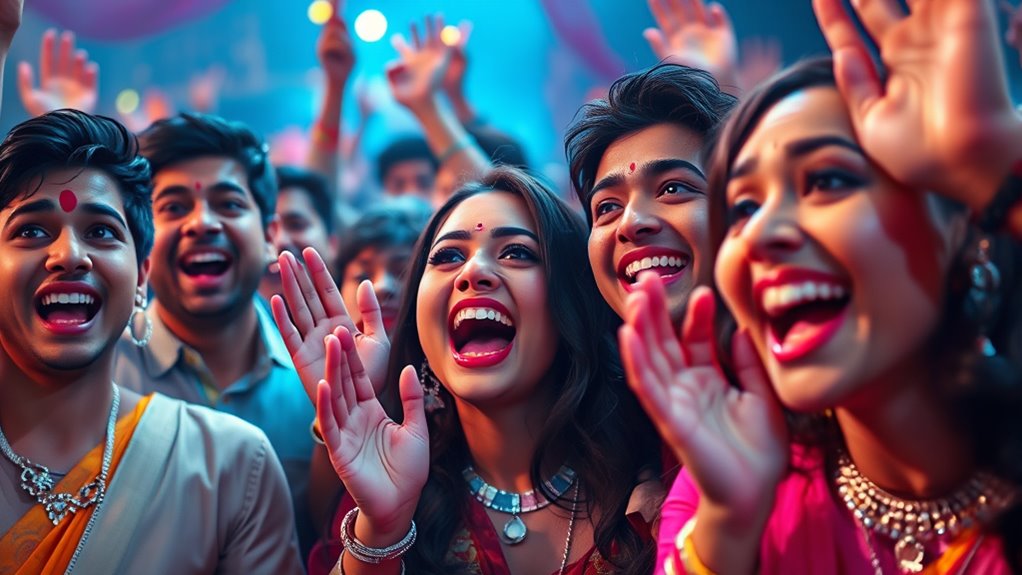
Have you ever wondered why words like “jhakaas” and “dhaansu” pack such a punch in conversations? These terms do more than just praise—they energize and add emotion to your words. “Jhakaas” expresses excitement and admiration, often used to highlight something fantastic or impressive, making your enthusiasm clear. “Dhaansu,” on the other hand, emphasizes impact and grandeur, conveying that something is truly outstanding or powerful. Both words elevate everyday conversations, especially among youth and Bollywood fans. They serve as linguistic tools to share genuine approval quickly. Their popularity shows how Bollywood influences language, blending regional pride with pan-Indian slang culture. Using these words makes your speech more vibrant, relatable, and full of local flavor, capturing the true spirit of Indian street and film dialogue. Additionally, the adoption of such slang underscores the influence of AI-driven social media trends in shaping contemporary linguistic expressions. Recognizing the transformative power of slang can help in appreciating how language evolves through popular culture and media. This dynamic interplay between media and language demonstrates the evolving linguistic landscape of modern India.
Describing People: Pataka, Fullmoon, and Yaar

You’ve probably heard friends call someone a *pataka* when they look stunning and confident. Casual terms like *yaar* show closeness and friendliness, making conversations more relaxed. While *fullmoon* isn’t common slang, it might be used metaphorically to describe someone radiating energy or brightness. “Fullmoon” can also symbolize someone who is shining brightly in a social setting or standing out in a crowd. In the context of remote hackathons, participants often stand out by showcasing innovative ideas and energetic participation, much like a *fullmoon* lighting up the night sky. Additionally, the contrast ratio of a projector impacts how vividly such standout moments appear on screen, highlighting the importance of high contrast for dynamic visuals. The way candies are freeze-dried to preserve their flavors and textures reflects the precision needed to create visually striking and memorable scenes in films or events. Understanding relationship dynamics can also help in appreciating how personalities shine or fade in social interactions. Moreover, recognizing cheating behaviors and their impact on trust can deepen our understanding of interpersonal relationships.
Striking Looks and Style
In Bollywood slang, describing someone’s appearance or style often involves vibrant and playful terms that capture attention and admiration. Terms like “pataka” evoke images of someone who’s striking and eye-catching, especially among women. It’s a lively way to praise a bold, attractive look, but remember, it’s best used in friendly contexts. “Fullmoon” might be poetic, hinting at a radiant glow, while “yaar” is more about camaraderie than looks. Here’s a quick insight:
| Term | Meaning | Usage Tip |
|---|---|---|
| Pataka | Firecracker, eye-catching woman | Use in fun, casual settings |
| Fullmoon | Radiant, glowing beauty | More poetic, rare slang |
| Yaar | Friend, buddy (not style) | Compliments often include it |
These words add color and fun to Bollywood style talk. Patāka, as a gesture, also symbolizes a striking and confident expression, often used to convey boldness or to emphasize a point, making it a fitting metaphor for someone with a standout, attention-grabbing style. Recognizing the cultural context behind these terms can help you use them appropriately in conversation. Additionally, understanding the popularity of slang in media and entertainment can also influence how widespread and accepted these terms become in everyday speech. Being aware of the social setting where these words are appropriate can help avoid misunderstandings. Understanding the linguistic nuances of these terms can further enhance your appreciation of Bollywood slang.
Casual Friendly Terms
Casual friendly terms like “pataka,” “fullmoon,” and “yaar” add a lively flavor to Bollywood conversations about people. “Pataka” literally means “firecracker” and is used to describe someone attractive, bold, and full of energy—usually a woman who stands out. It’s a playful compliment, though some may find it offensive if used insensitively. “Yaar” is a common term for a friend or buddy, conveying warmth and camaraderie. It’s versatile, used to address friends or as a casual filler in speech. “Fullmoon,” however, isn’t widely recognized as slang in Bollywood. It might be used poetically or metaphorically but lacks popular usage or clear meaning in casual contexts. Interestingly, the popularity of slang terms often influences their acceptance and use in everyday conversations, making some terms more common than others. These terms help make conversations lively and relatable, reflecting the informal, friendly spirit of Bollywood dialogues. Incorporating contemporary slang can make your speech sound more natural and in sync with everyday Hindi conversations. Understanding the emotional dynamics behind these terms can also enhance how you connect with people in casual conversations, especially considering the significance of popularity and recognition of certain slang terms in modern media. Additionally, being aware of how context influences meaning can help avoid misunderstandings when using these lively expressions.
Common Insults: Chirkut, Dhakkan, and Kalti Maar
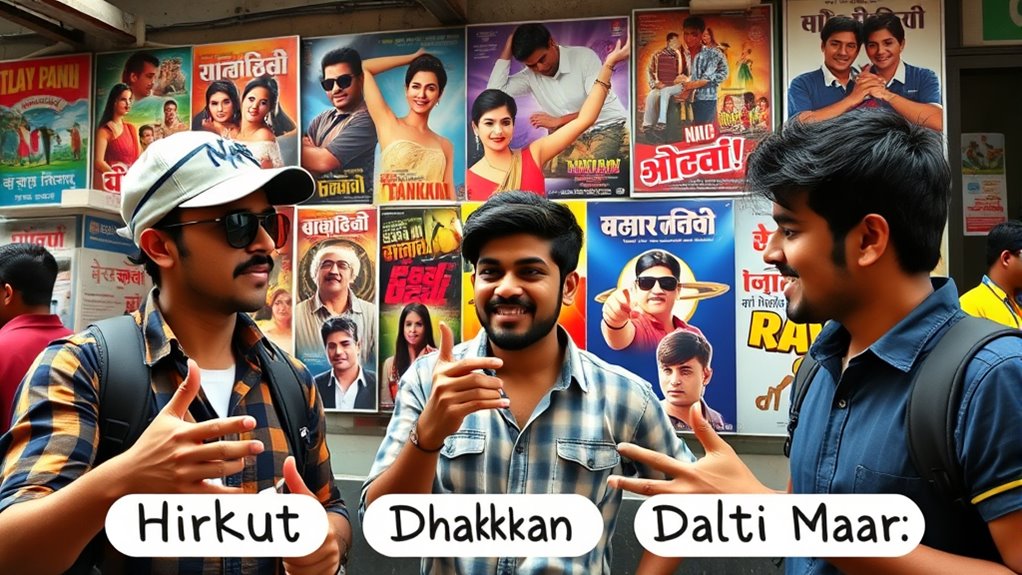
You’ll notice Bollywood often uses playful insults like “Chirkut,” which are meant to tease rather than offend. These terms reflect a cultural trend of lighthearted name-calling that fits specific social contexts. Knowing when and how to use them helps you understand their humor and avoid misunderstandings. Furthermore, these words are typically used among friends or in informal settings to maintain a friendly tone.
Playful Name-Calling Trends
Playful name-calling has become a popular trend in Bollywood slang, often used to tease or insult friends and rivals in a humorous way. Terms like “Chirkut” are used to label someone as stupid, impetuous, or lacking class, often implying they’re insignificant. You might hear it in movies like “Bandook,” where “Chirkut Cowboys” reflect the characters’ personas. “Dhakkan” is another light insult, meaning a fool or someone lacking intelligence, usually used informally to show disappointment. “Kalti Maar” isn’t widely documented but may be regional or colloquial, possibly meaning to dismiss or dismissively hit back at someone. These terms keep the mood light, allowing playful banter without serious offense, making them popular in casual conversations. The use of such slang aligns with the cultural context of Bollywood, where humor often blends with sharp wit. Understanding the linguistic nuances behind these terms can help in appreciating their playful nature and how they reflect social interactions. Incorporating antique-inspired decor elements can also add a charming touch to casual or playful spaces, creating a warm and inviting atmosphere.
Cultural Context of Insults
In Bollywood slang, insults like “Chirkut,” “Dhakkan,” and “Kalti Maar” serve more than just teasing; they reflect deep cultural nuances and social attitudes. These terms aren’t just name-calling—they reveal what society values and how humor is used to highlight character traits. For example, “Chirkut” is common in North India, emphasizing a person’s lack of class or intelligence. “Dhakkan” universally signals foolishness, while “Kalti Maar” hints at incompetence. These insults are often woven into scripts to entertain, create humor, or deepen characters. They serve as cultural markers, connecting audiences through shared language and social understanding. Here’s a quick look at their emotional impact:
| Emotion/Impact | Example/Explanation |
|---|---|
| Humor | Lighthearted teasing |
| Characterization | Showing stupidity or wit |
| Cultural Identity | Regional language usage |
| Social Commentary | Reflecting stereotypes |
| Audience Connection | Relatability and authenticity |
Furthermore, the use of regional slang like these highlights the cultural diversity present within Bollywood films, making dialogues more authentic and relatable for local audiences. Additionally, understanding these slang terms can enhance a viewer’s appreciation of the local dialects that enrich Indian cinema. Recognizing how these terms function within the social context helps viewers grasp the nuances of humor and characterization in Indian films. Moreover, the way these insults are used in dialogue often reflects underlying social hierarchies and relationships, adding depth to storytelling.
When to Use Them
Common insults like “Chirkut,” “Dhakkan,” and “Kalti Maar” are typically reserved for informal settings where humor and familiarity are understood. You should use these terms among friends or in casual conversations, not in formal or professional environments, to avoid offending others. In movies, these insults help add realism and humor, often heightening the scene’s mood. They can also lighten a tense moment or emphasize a character’s frustration, depending on the context. Keep in mind regional differences; some insults are more common in certain areas. Using them appropriately requires awareness of social norms to prevent misunderstandings or offense. When in doubt, gauge the situation and your audience before tossing these slang terms into your conversation. Additionally, understanding the cultural context can enhance your appreciation of their usage in dialogue.
Slang for Casual and Fun Situations: Mast, Khali Peeli, and Gyaan
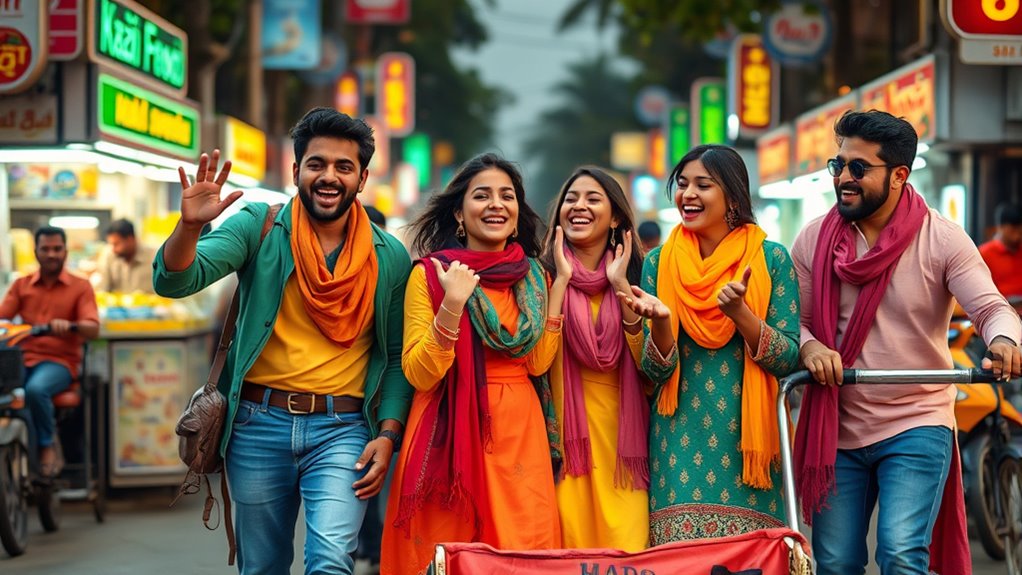
Bollywood slang like *Mast*, *Khali Peeli*, and *Gyaan* adds a lively and relatable flavor to casual conversations and fun situations. When something’s really enjoyable or impressive, you’ll often hear *Mast* used to express your excitement or approval. If you want to criticize someone for lacking substance or effort, *Khali Peeli* fits perfectly, implying emptiness or superficiality. Meanwhile, *Gyaan* is used to praise someone’s insight or wisdom, often in a light-hearted way. These terms are popular in everyday chat, movies, and social media, helping you sound authentic and connected to Indian culture. Whether celebrating a fun event or joking around, using these slang words makes your conversations more colorful and genuine.
Youth and Bollywood-Inspired Terms: Jugaad, Chull, and Bakchodi

Youth culture in India is heavily influenced by Bollywood, which has popularized terms like jugaad, chull, and bakchodi that perfectly capture the spirit of young, urban Indians. Jugaad represents the art of resourcefulness—finding creative solutions with limited resources, embodying resilience and innovation. Chull reflects a carefree, lively attitude, often associated with social gatherings and spontaneous fun, showcasing youthful camaraderie. Bakchodi signifies playful banter and mischief, highlighting the humor and irreverence common among friends. These terms blend traditional Indian ingenuity with modern youth expression, often featured in Bollywood movies to depict authentic social scenarios. Their widespread use shapes everyday language, making Bollywood slang an essential part of contemporary Indian youth identity.
- Emphasizes resourcefulness and creativity
- Embodies carefree, energetic social vibes
- Captures humor, mischief, and camaraderie
- Connects traditional values with modern youth culture
Expressing Amazement and Excitement: Kya Baat Hai! and Jhakkas

Expressions of amazement and excitement like “Kya Baat Hai!” and “Jhakkas” capture the lively, celebratory spirit that Bollywood and Indian youth culture radiate. When you hear “Kya Baat Hai!”, it’s not just a question but an exclamation of joy, surprise, or admiration—similar to “Wow!” or “Amazing!” in English. You can use it to praise achievements, good news, or performances, whether in conversations or social media. “Jhakkas” is another trendy term from Mumbai street slang, meaning “awesome” or “fantastic.” It’s often used to praise someone or something impressive, signaling style and trendiness. Both phrases foster a cheerful vibe, strengthen social bonds, and show your enthusiasm, making conversations more lively and connected.
Cultural Nuances: Desi, Pataka, and Fullmoon
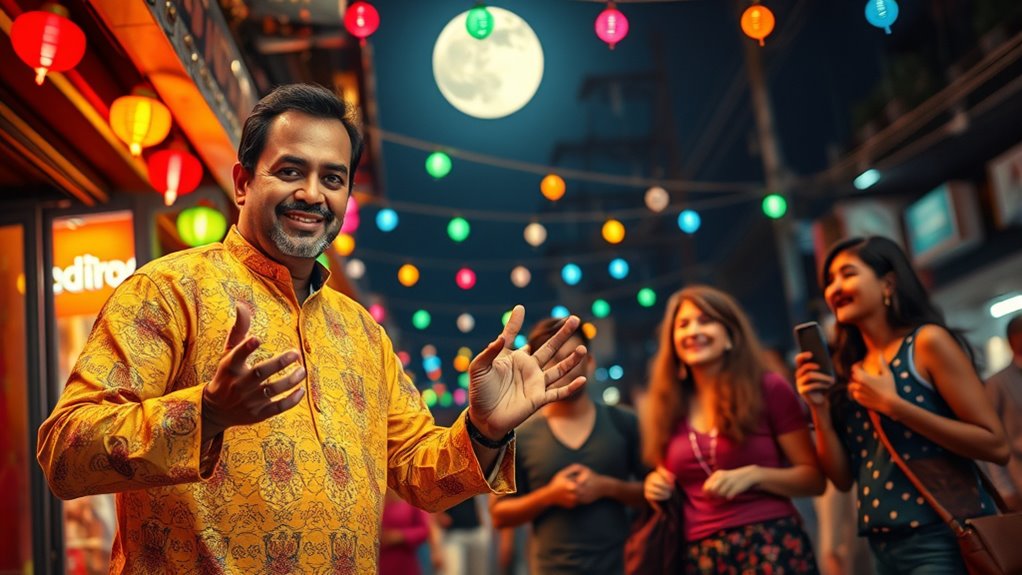
Cultural nuances like Desi, Pataka, and Fullmoon reveal how Bollywood blends tradition with modernity to communicate identity, admiration, and moments of significance. These terms reflect deeper societal values while adding flavor to dialogue and storytelling. You’ll notice Desi emphasizes pride in South Asian roots, often evoking nostalgia and cultural belonging. Pataka captures the fiery charm and boldness of a woman, symbolizing attractiveness and vivacity. Fullmoon, a more contemporary slang, symbolizes completeness, peak moments, or beauty, often used metaphorically to heighten drama or humor. These words showcase Bollywood’s ability to merge traditional symbolism with modern slang, creating layered meanings. They also serve as cultural markers, connecting audiences emotionally and socially through expressive language.
Bollywood blends tradition and modernity through Desi, Pataka, and Fullmoon, capturing cultural pride, boldness, and poetic symbolism.
- Emphasize cultural identity and pride
- Highlight gendered stereotypes and admiration
- Incorporate poetic and symbolic imagery
- Reflect Bollywood’s hybrid cultural influences
Slang for Dismissal and Boredom: Kantalaa and Kalti Maar

Bollywood’s vibrant storytelling often incorporates street slang that captures authentic emotions and social interactions. When you hear “Kalti Maar,” it’s a casual, assertive way to tell someone to leave or get lost, often used humorously in Mumbai’s street culture. For example, “Kalti maar yahan se” means “Get lost from here.” On the other hand, “Kantalaa” expresses boredom or exhaustion, reflecting a feeling of disinterest. People use it to show they’re tired of an activity, like saying, “Kantalaa aaya yaar,” meaning they’re fed up. These terms come from Bambaiya Hindi and Marathi, adding regional flavor to Bollywood dialogues. They help characters feel more authentic and relatable, especially in scenes depicting street life, social dismissals, or moments of boredom.
Popular Terms for Describing Style and Attitude: Fattu, Bindaas, and Funda

When characters in movies or conversations describe someone’s attitude or style, they often use slang like “Fattu,” “Bindaas,” and “Funda” to quickly convey personality traits. These terms help reveal a person’s courage, confidence, or mindset instantly.
- “Fattu” comes from Hindi slang, meaning someone who’s cowardly or scared, often used humorously or teasingly.
- “Bindaas” is a Marathi word embraced in Bollywood, describing someone carefree, bold, and fearless.
- “Funda” is short for “fundamental,” used to highlight a key idea, principle, or strategy in a simple way.
- These words are popular in dialogues, social media, and youth conversations, adding authenticity and flavor to character portrayals.
Frequently Asked Questions
How Did Bollywood Slang Originate and Become Mainstream?
You’re curious about how Bollywood slang started and gained popularity. It began in the 1970s, with journalists coining the term “Bollywood” to describe Mumbai’s film industry. Over time, magazines, media, and fan communities popularized slang by blending Indian and Western influences. Social media and international recognition helped it spread globally, making Bollywood slang a key part of Indian culture and a symbol of the industry’s vibrant, diverse appeal.
Are These Slang Terms Used Differently Across Indian Regions?
Did you know that regional variations shape Bollywood slang usage? You’ll find terms like “Fattu” popular in North India, while South Indian regions use different equivalents. You may notice pronunciation differences influenced by local accents, like Punjabi or Tamil. These variations reflect cultural identities, and social media helps spread slang across regions. So, your favorite slang might sound different depending on where you are in India, giving each region its unique flavor.
Can Non-Indian Audiences Understand These Bollywood Slang Terms?
You might wonder if non-Indian audiences can understand Bollywood slang. The good news is, yes, they can! Subtitles, translations, and cultural explanations make it easier. Watching movies with subtitles helps you catch the meaning. Also, exploring online resources and participating in cultural events can deepen your understanding. With some effort, you’ll find these slang terms become familiar, enriching your appreciation of Bollywood movies and Indian culture.
What Are Some Slang Terms for Expressing Love or Affection?
You want to know slang terms for expressing love or affection in Hindi. You might hear words like प्यार (pyaar), प्रेम (prem), or इश्क़ (ishq) for deep romantic feelings. Casual terms like जान (jaan), जानू (janu), or शोना (shona) are used for loved ones. Phrases such as मैं तुमसे प्यार करता हूँ (I love you) and तुम मेरी जिंदगी हो (You are my life) convey heartfelt emotions.
How Do Bollywood Slang Terms Evolve With Modern Social Media Trends?
Picture Bollywood slang as a flowing river, constantly changing with the currents of social media. You see, as platforms like Instagram and YouTube Shorts grow, slang evolves fast—viral challenges, memes, and influencer trends remix phrases into new, playful meanings. You, as a user, influence this flow, blending regional dialects, humor, and internet lingo, making Bollywood slang a vibrant, living language that reflects modern youth culture and keeps pace with digital evolution.
Conclusion
Just like a Bollywood blockbuster, mastering these slang words adds color and flair to your conversations. Think of them as your secret scripts, turning ordinary chats into lively scenes full of drama, humor, and attitude. With these terms, you’re not just speaking—you’re performing on your own cinematic stage. So, go ahead, sprinkle some desi magic, and let your words shine brighter than the spotlight!
